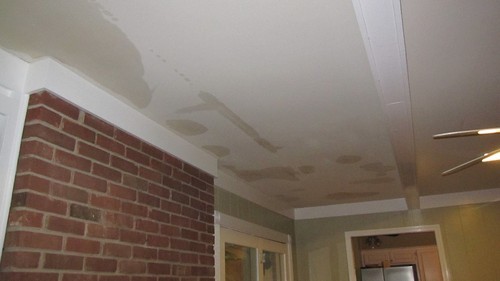Water damage on ceilings can be a major problem. It can lead to mold growth, structural damage, and other issues. If you notice any signs of water damage on your ceiling, it is important to take action immediately to prevent further damage.
In this article, we will discuss the signs of water damage on ceilings, how to identify them, and what to do if you find them.

Signs of Water Damage on Ceilings
There are a number of signs that can indicate water damage on ceilings. Some of the most common signs include:
- Wet spots or stains: Water damage will often appear as wet spots or stains on the ceiling. These stains can be brown, black, or another color.
- Blisters or bubbles: Water damage can also cause blisters or bubbles to form on the ceiling. These blisters or bubbles are caused by water that has seeped between the layers of drywall.
- Mold or mildew growth: Mold and mildew can grow on ceilings that have been exposed to water damage. Mold and mildew can cause health problems, so it is important to remove them as soon as possible.
- Drywall damage: Water damage can also cause drywall to become damaged. This damage can appear as cracks, holes, or other imperfections in the drywall.
- Sagging or bowing: In severe cases, water damage can cause the ceiling to sag or bow. This is a sign that the damage is significant and that structural repairs may be necessary.
- Musty odor: Water damage can also cause a musty odor in the home. This odor is caused by mold and mildew growth.
Identifying Water Damage
If you notice any of the signs of water damage on your ceiling, it is important to identify the source of the leak. This will help you to determine the best course of action for repair.
Here are a few tips for identifying the source of a leak:
- Check for leaks in plumbing fixtures: Leaks in plumbing fixtures, such as faucets, toilets, and showers, are a common cause of water damage on ceilings.
- Inspect the roof: Leaks in the roof can also cause water damage on ceilings.
- Check for leaks in the attic: Leaks in the attic can also cause water damage on ceilings.
- Check for leaks in the walls: Leaks in the walls can also cause water damage on ceilings.
Repairing Water Damage
Once you have identified the source of the leak, you can begin repairing the water damage. The specific steps you will need to take will vary depending on the cause of the leak.
In general, you will need to take the following steps to repair water damage:
- Stop the leak: The first step is to stop the leak. This may involve repairing a leaky pipe, replacing damaged caulking or sealant, or clearing a clogged drain.
- Clean up the damage: Once the leak has been stopped, you will need to clean up any damage that has already occurred. This may involve removing wet drywall, scraping mold, or repairing structural damage.
- Dry the area: It is important to dry the area completely before you begin repairs. This will help to prevent mold and mildew growth.
- Make repairs: Once the area is dry, you can begin making repairs. This may involve replacing damaged drywall, repairing structural damage, or applying a sealant to prevent future leaks.
Preventing Water Damage
The best way to prevent water damage on ceilings is to take steps to prevent leaks. Here are a few tips for preventing leaks:
- Regularly inspect your plumbing fixtures for leaks.
- Have your roof inspected and repaired by a professional regularly.
- Check your attic for leaks regularly.
- Seal any cracks or holes in your walls or ceiling.
Conclusion
Water damage on ceilings can be a major problem. By being aware of the signs of water damage and taking steps to prevent leaks, you can help to protect your home from this damage.